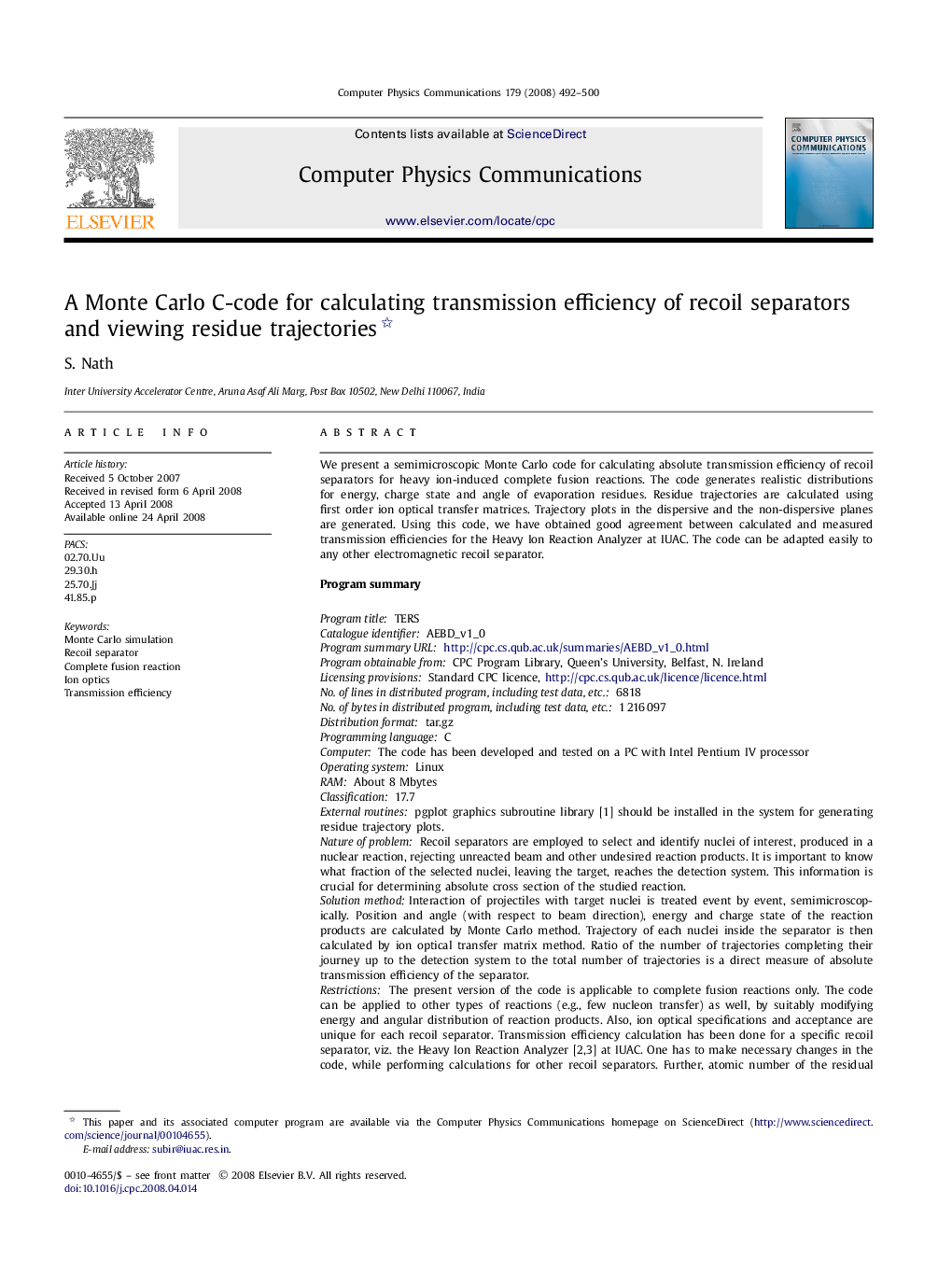| کد مقاله | کد نشریه | سال انتشار | مقاله انگلیسی | نسخه تمام متن |
|---|---|---|---|---|
| 502932 | 863730 | 2008 | 9 صفحه PDF | دانلود رایگان |

We present a semimicroscopic Monte Carlo code for calculating absolute transmission efficiency of recoil separators for heavy ion-induced complete fusion reactions. The code generates realistic distributions for energy, charge state and angle of evaporation residues. Residue trajectories are calculated using first order ion optical transfer matrices. Trajectory plots in the dispersive and the non-dispersive planes are generated. Using this code, we have obtained good agreement between calculated and measured transmission efficiencies for the Heavy Ion Reaction Analyzer at IUAC. The code can be adapted easily to any other electromagnetic recoil separator.Program summaryProgram title: TERSCatalogue identifier: AEBD_v1_0Program summary URL:http://cpc.cs.qub.ac.uk/summaries/AEBD_v1_0.htmlProgram obtainable from: CPC Program Library, Queen's University, Belfast, N. IrelandLicensing provisions: Standard CPC licence, http://cpc.cs.qub.ac.uk/licence/licence.htmlNo. of lines in distributed program, including test data, etc.: 6818No. of bytes in distributed program, including test data, etc.: 1 216 097Distribution format: tar.gzProgramming language: CComputer: The code has been developed and tested on a PC with Intel Pentium IV processorOperating system: LinuxRAM: About 8 MbytesClassification: 17.7External routines: pgplot graphics subroutine library [1] should be installed in the system for generating residue trajectory plots.Nature of problem: Recoil separators are employed to select and identify nuclei of interest, produced in a nuclear reaction, rejecting unreacted beam and other undesired reaction products. It is important to know what fraction of the selected nuclei, leaving the target, reaches the detection system. This information is crucial for determining absolute cross section of the studied reaction.Solution method:Interaction of projectiles with target nuclei is treated event by event, semimicroscopically. Position and angle (with respect to beam direction), energy and charge state of the reaction products are calculated by Monte Carlo method. Trajectory of each nuclei inside the separator is then calculated by ion optical transfer matrix method. Ratio of the number of trajectories completing their journey up to the detection system to the total number of trajectories is a direct measure of absolute transmission efficiency of the separator.Restrictions: The present version of the code is applicable to complete fusion reactions only. The code can be applied to other types of reactions (e.g., few nucleon transfer) as well, by suitably modifying energy and angular distribution of reaction products. Also, ion optical specifications and acceptance are unique for each recoil separator. Transmission efficiency calculation has been done for a specific recoil separator, viz. the Heavy Ion Reaction Analyzer [2,3] at IUAC. One has to make necessary changes in the code, while performing calculations for other recoil separators. Further, atomic number of the residual nucleus should not exceed 92, as the method used for calculating stopping power of ions [4] is valid for Z⩽92Z⩽92.Running time: From few seconds to several minutes depending on the reaction, number of events and separator layout.References:[1]http://www.astro.caltech.edu/~tjp/pgplot/.[2]A.K. Sinha, N. Madhavan, J.J. Das, P. Sugathan, D.O. Kataria, A.P. Patro, G.K. Mehta, Nucl. Instr. Methods A 339 (1994) 543.[3]S. Nath, Nucl. Instr. Methods A 576 (2007) 403.[4]J.F. Ziegler, J.P. Biersack, U. Littmark, The Stopping and Range of Ions in Solids, vol. I, Pergamon Press, Oxford, 1984.
Journal: Computer Physics Communications - Volume 179, Issue 7, 1 October 2008, Pages 492–500